Featured courses
- Complete Youth Hockey Practice Plan by Jacob Crabtree
- Zone Entry Hockey Drills: How to Teach Effective Entries by Jackson Chlebowy
- Hockey Practice Plan: Maximize Development in Every Session by Jackson Chlebowy
- Strength and Conditioning for Ice Hockey: Building the Complete Athlete by Jackson Chlebowy
- Hockey Defensive Positioning: Skills for Forwards and Defensemen by Jackson Chlebowy
- Which Hockey Position Should I Play? | Hockey Positions Guide by Jackson Chlebowy
- 3 Keys to Hockey Defense: Dominate the Defensive Zone by Jackson Chlebowy
- 4 Hockey Skating Drills for Youth Players: Building Speed, Balance, and Agility by Jackson Chlebowy
- 4 Hockey Passing Drills to Improve Team Performance: Mites to Peewees by Jackson Chlebowy
- Mastering the Hockey Forecheck: 6 Keys and Strategies by Jackson Chlebowy
- How To Coach Hockey: Creating a Winning Culture by Jackson Chlebowy
- 5 Principles of a Successful Hockey Power Play by Jackson Chlebowy
- Three Youth Hockey Shooting Drills to Score More Goals by Jackson Chlebowy
- 3 Hockey Battle Drills to Improve Compete Level and Team Chemistry by Jackson Chlebowy
- Ice Hockey Goalie Drills: Mastering the Basics by Emma Martin
- Tips and Tricks on Perfecting Your Hockey Slap Shot by Emma Martin
- 7 Effective Puck Protection Drills for Defenseman by Jacob Crabtree
- Strength and Conditioning: Tony Greco's Principles of Strength by Jacob Crabtree
- From Humble Beginnings to Highly Respected NHL Shooting Coach – A Sit-down with Tim Turk by Slava Paller
- Journey into Strength and Conditioning with NHL athletes to everyday people with Ryan Van Asten: Two time Stanley Cup Champion and Current Calgary Flames Strength and Conditioning Coach by Clarence Paller
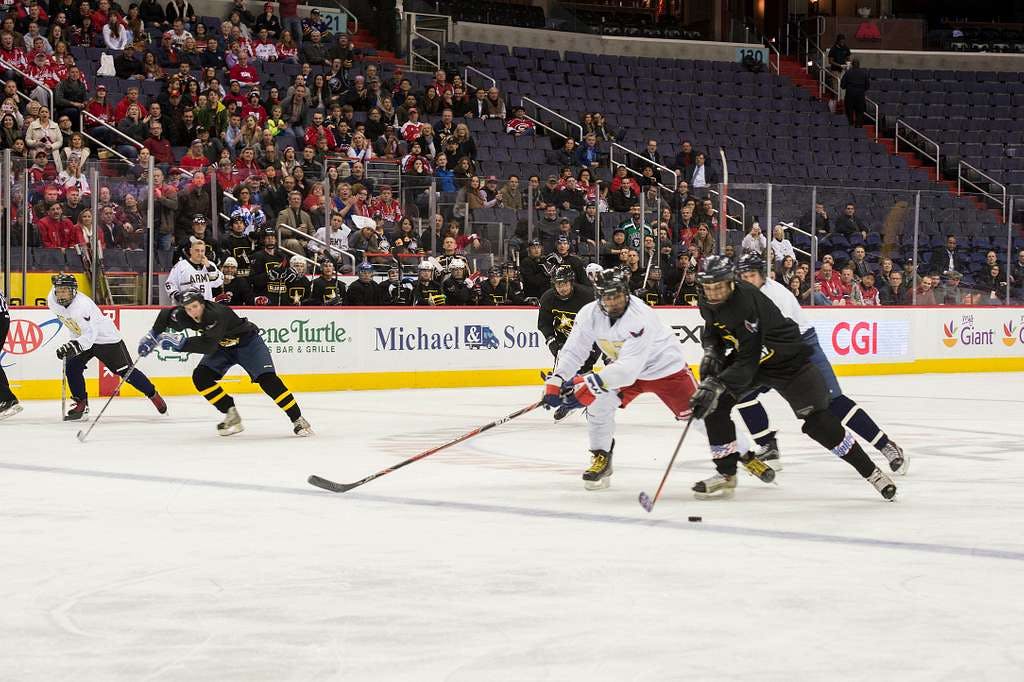
Zone Entry Hockey Drills: How to Teach Effective Entries
Why Zone Entries Matter
According to skill coach Mike Pilon and video analysis of NHL entries:
- Sixty percent of successful entries are carry-ins (not dump-ins).
- Possession entries lead to more shots and more scoring chances.
- Deception, support, spacing, and puck movement are perhaps the keys.
Coaches will have to move beyond "dump and chase" and teach kids how to enter with control, with the timing and support of the puck as their foundations.
__________________________________________________________________________________________________________________
4 Teaching Points for Better Zone Entries
In Coach Pilons 'On-Ice Skill' course, he goes in-depth on the zone entry. Here are his 4 teaching points for better zone entries.
1. Support the Puck
Players must work in straight lines and provide back or lateral support—never ahead of the puck carrier without a purposeful reason. Support means having options to pass and stopping turnovers from happening at the blue line.
2. Enter with Speed and Width
Encourage wingers to stay wide, close to the boards or dots-rather than crowding the middle lane where defenders are able to close the gaps quickly.
3. Sell Deception
Head faking, body positioning, and look-offs might freeze the defenders and goalies momentarily. Even something as minor as fake shots or looking in the middle before passing wide can hugely impact entry successes.
4. Manipulate the Defense
Tell your players to look at the defender's stick and take what the defender gives them. The worst thing a player can do is turn the puck over at the blue line. Use body positioning, speed (or varying speed), stops and starts, or chips and drop passes to manipulate defensive positioning.
__________________________________________________________________________________________________________________
10 Great Zone Entry Hockey Drills
Use these drills to reinforce the teaching points above while helping players get repetitions within a structure:
1. Middle Kick Wide Drill
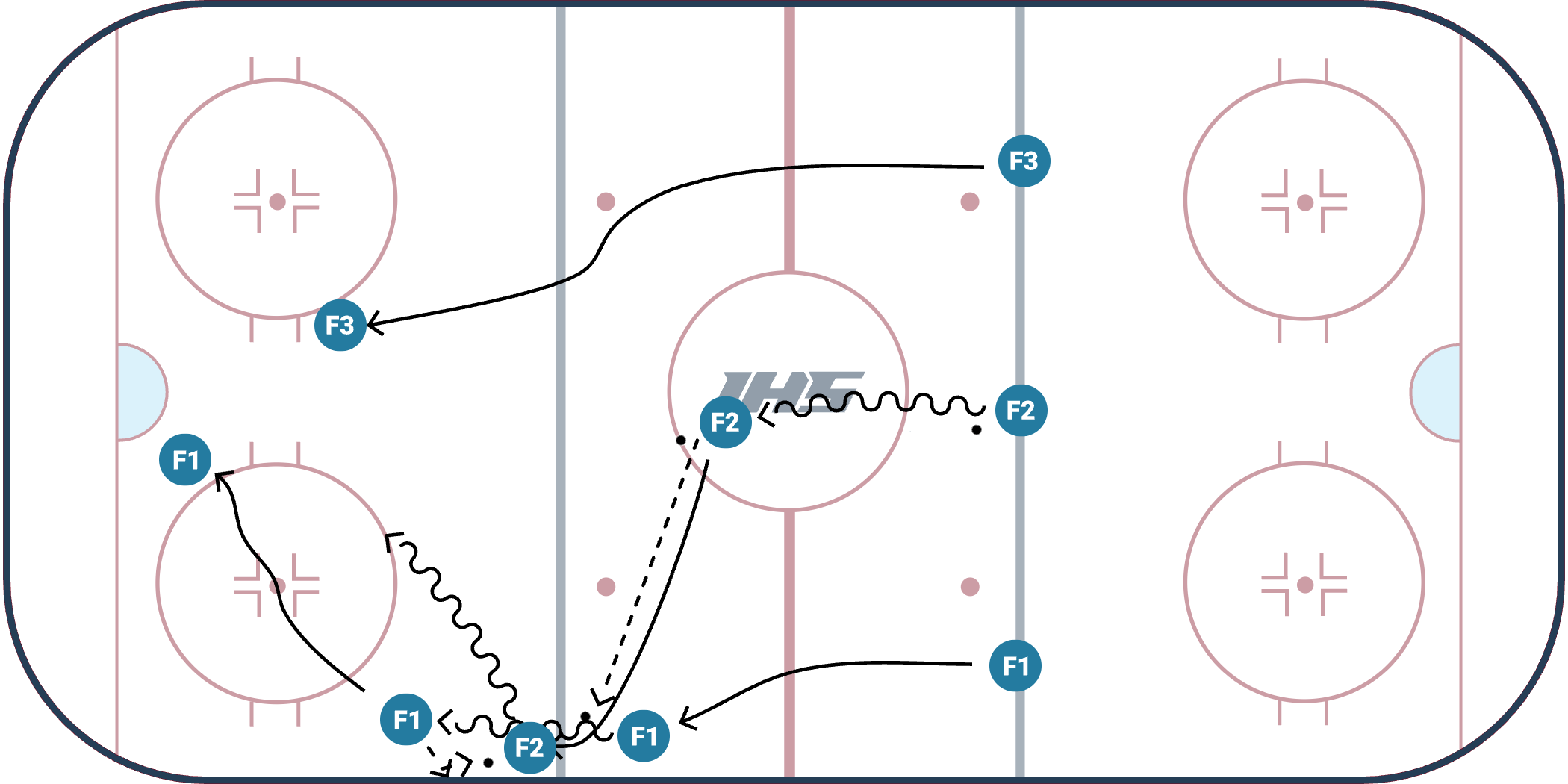
- Puck in the middle to start
- Pass wide to the winger.
- Middle lane skater loops behind for puck support.
- Chip off the wall or direct pass depending on space.
2. Wall Chip Entry
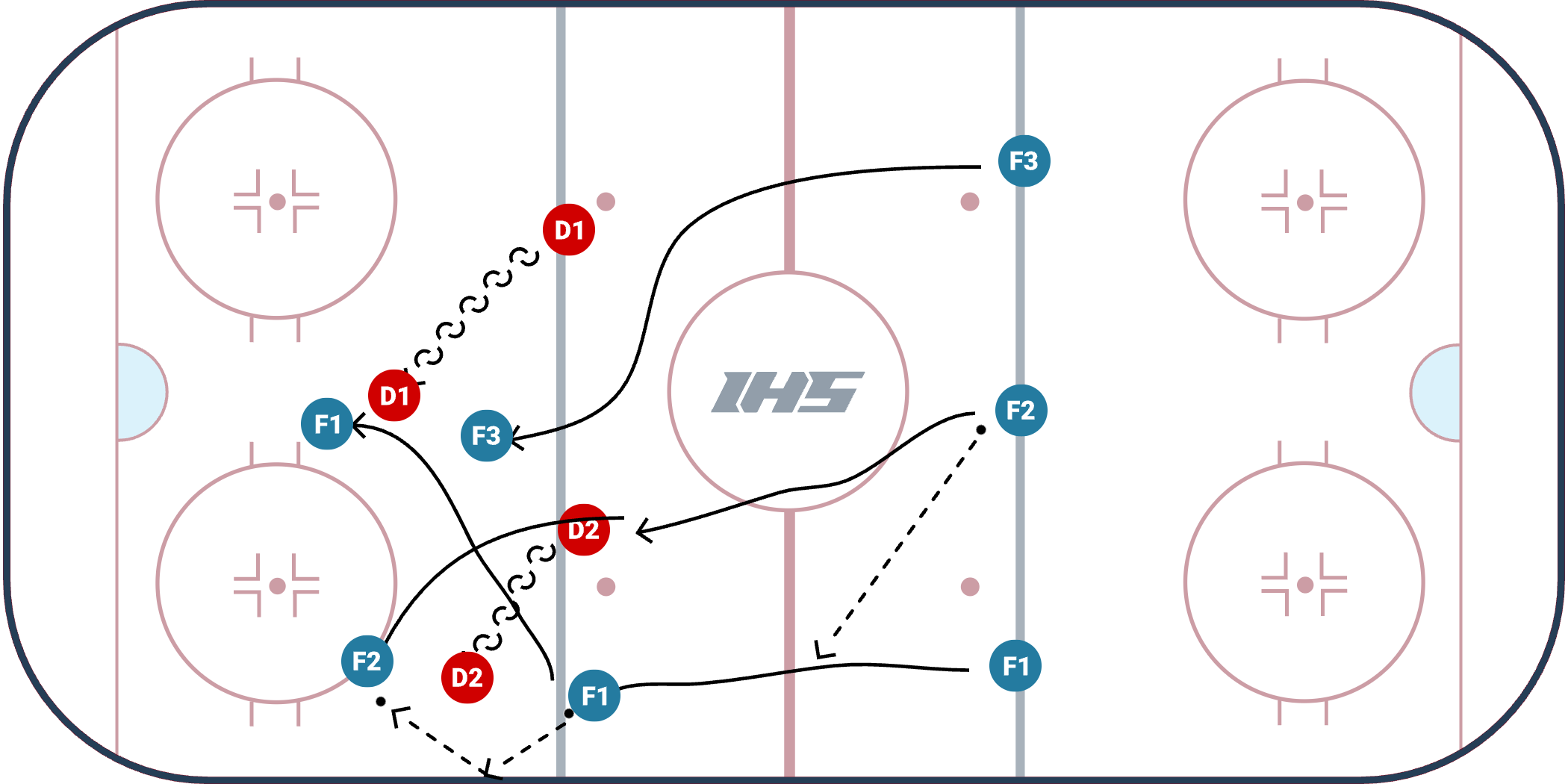
- Winger catches a pass near the boards.
- Chips puck along the boards past the defenseman.
- Center supports wide and picks up puck with speed.
3. Fake Shot Drop Pass
- Carrier skates down the wall.
- Looks at the net as if shooting.
- Drops puck behind to trailing player aligning with their stick blade.
- Quick shot on goal.
4. Two-on-One Carry and Dish
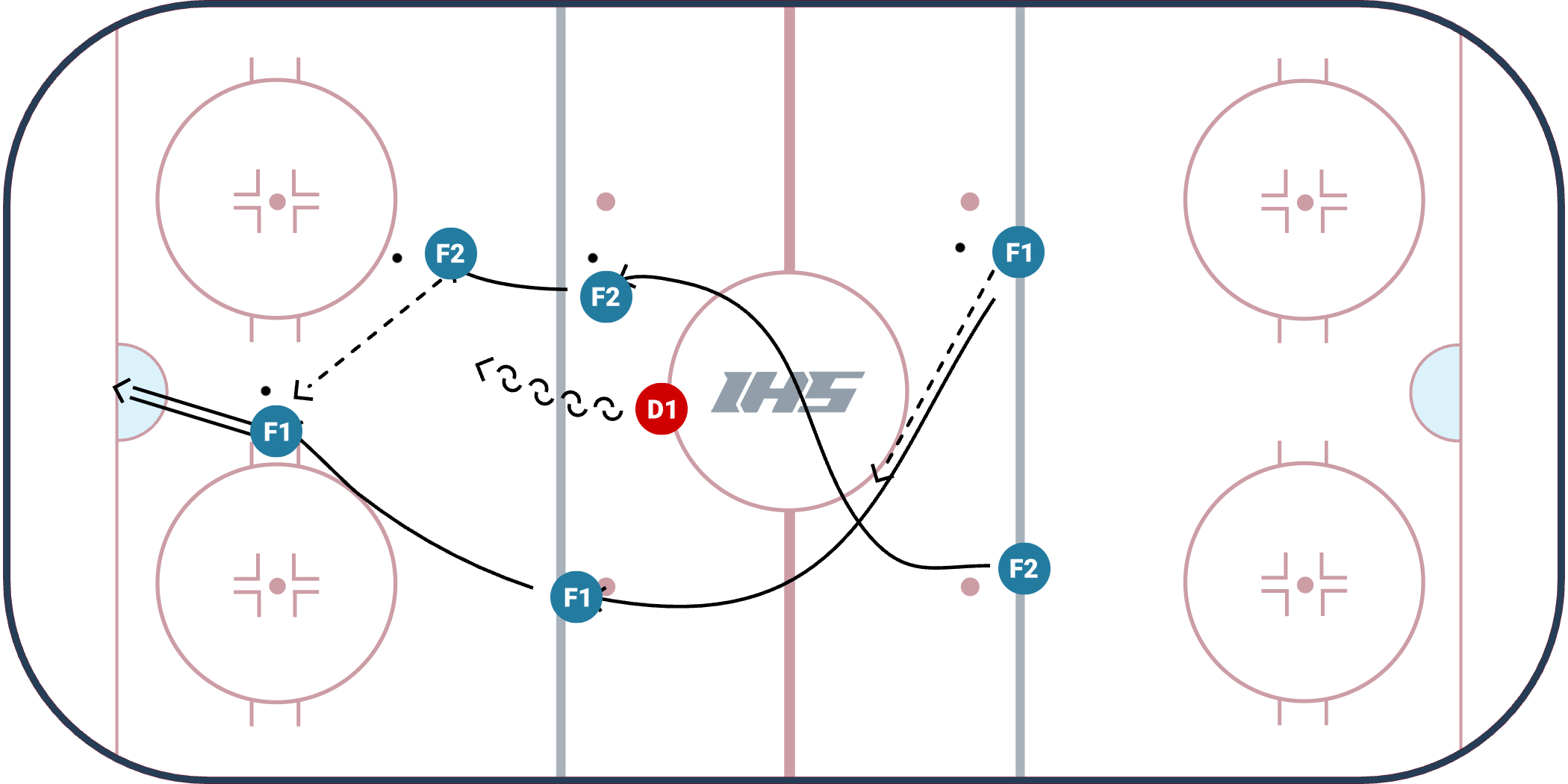
- Early passing emphasis.
- Teach the players to make the goalie and the defender respect the pass by looking middle.
- Finish off with a shot on the pass.
5. Delayed Entry Layer

- Puck carrier goes in alone.
- Second player delays above the line.
- A drop or lateral pass to the delayed trailer continues the entry.
6. Zone Entry with Cross-Ice Pass
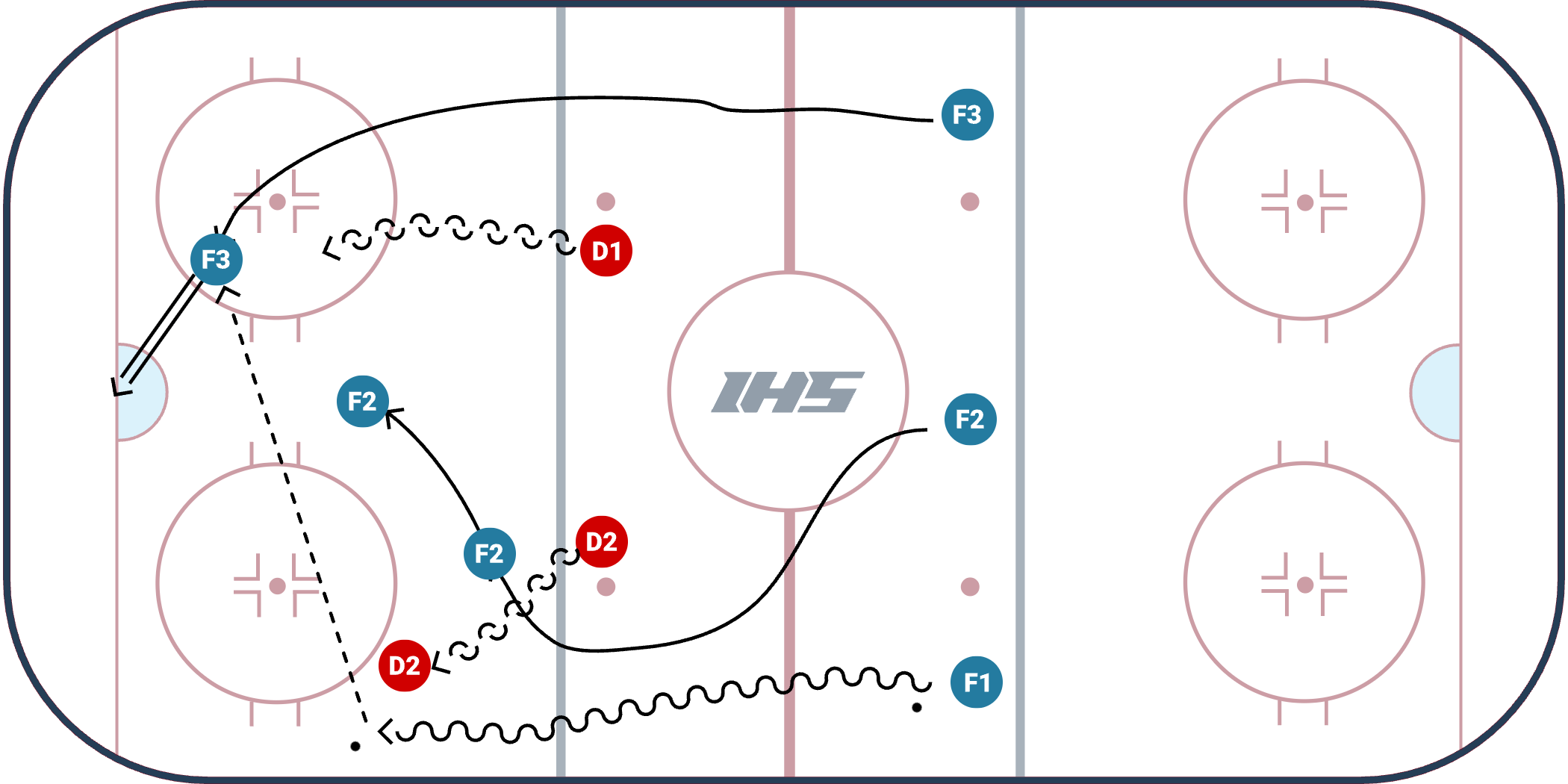
- Use zone entry to simulate an attack down the wide lane.
- Execute the cross-slot pass.
- Finish with a one-timer to emphasize spacing and timing.
7. Triangle Entry Attack
- Three forwards create a triangle at entry: one wide, one centre, one trailer.
- Force defenders to read too many options.
- Emphasis on puck support and communication.
8. Gap Recognition Entry
- Defender sets the gap early.
- Puck carrier reads the gap and decides to either carry, pass, or chip.
- A wonderful tool to develop decision-making under pressure.
9. Manipulate The Stick Drill
- Offensive player waits for defender to move that stick before passing.
- Promotes patience and timing.
- Reinforces passing lanes, effective fakes, and playmaking
10. Wide Delay Cutback

- Entry along the boards with a sudden stop or cutback.
- The second forward enters late to accept the puck in stride.
-Works on spacing and timing. __________________________________________________________________________________________________________________
Final Thoughts
Effective zone entries are crucial for generating offense. If taught with intention, speed, support, deception, and puck movement, your team should maintain possession longer and create more scoring opportunities.
